The LG X Power Review
by Brandon Chester on August 31, 2016 9:03 AM EST- Posted in
- Smartphones
- LG
- LG X Power
System Performance
As I mentioned on the first page, the LG X Power comes in two versions. The international model uses MediaTek's MT6735 SoC, which has four Cortex A53 cores with a peak frequency of 1.3GHz. The North American model uses Qualcomm's Snapdragon 212 SoC with four Cortex A7 cores that also reach a peak frequency of 1.3GHz. Depending on the workload, there can be a considerable performance difference between Cortex A7 and Cortex A53. I don't know why LG has opted to ship two models of the same phone with significantly different SoCs, and it would have made much more sense to use Snapdragon 410 in the North American market.
I don't have both models of the LG X Power available for review, so I can really only speak to the performance of the North American model. There will definitely be differences in CPU and GPU performance between the two, and it's also important to note that the international model has an additional 512MB of RAM. Since the LG X Power doesn't support OpenGL ES 3.1, I've cut some of the benchmarks from the standard group that I run. Below I've organized the remaining benchmarks into sections that represent what part of the system each benchmark tests.
App Performance

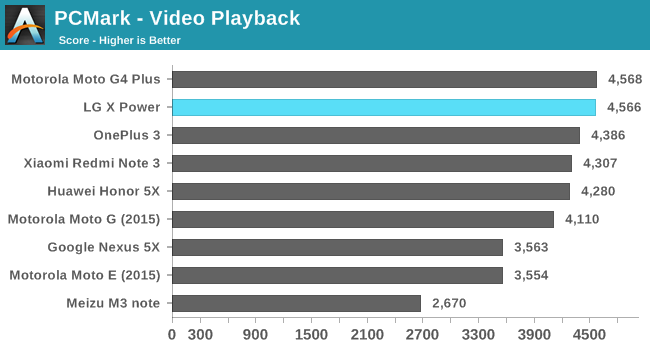

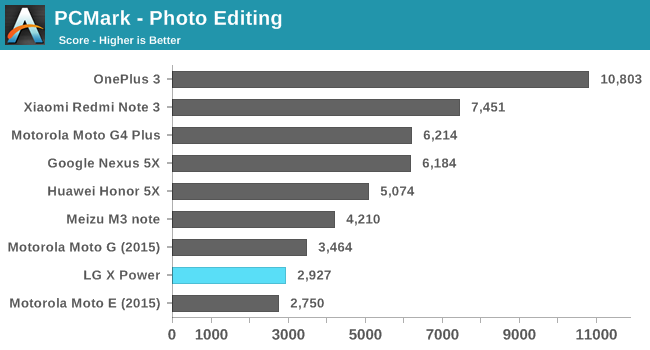
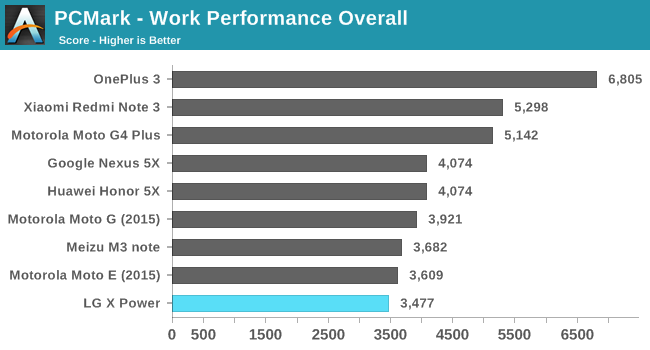
PCMark is a good benchmark because it simulates actions that users perform on a daily basis, and does so using the same system APIs as real applications. This makes it particularly sensitive to software optimizations, as well as changes in Android version that bring improvements to the Android API.
The LG X Power doesn't get off to a good start in PCMark. In every sub-test except the video playback test it is one of the slowest devices on record. While it doesn't come in very last in photo editing or writing, it's close enough that the devices it beats in those individual tests actually end up doing better when all the scores are aggregated, making the LG X Power the overall slowest device on record for PCMark.
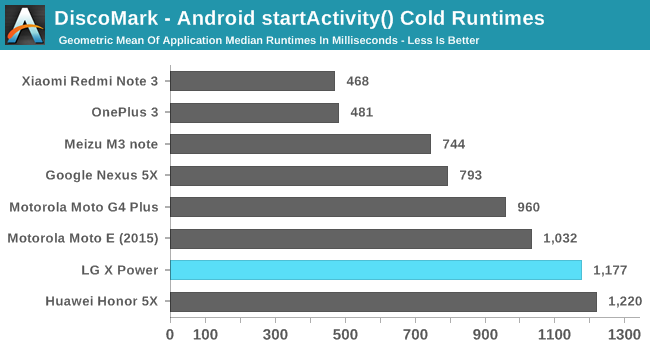
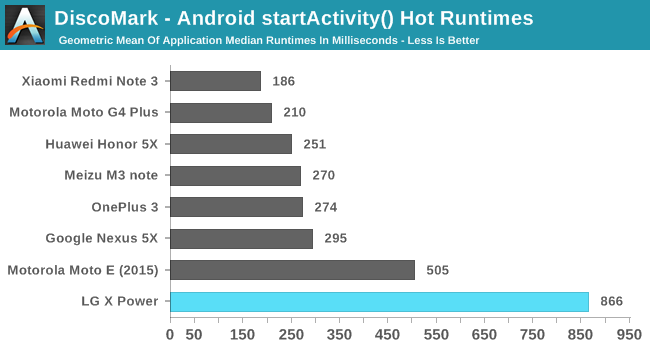
DiscoMark is a new addition to our benchmark suite. It allows us to measure the time it takes for an application to launch by monitoring how long it takes for an Activity to be created after a call to Android's startActivity method. For testing we have selected a group of commonly used applications, and the box-and-whisker diagrams allow the quickest and longest launch times for each app to be displayed, along with the first and third quartile boundaries. We also split the test into two parts, with the first being cold launches where an application has been killed before being launched, and hot launches where an application will still be resident in memory if the phone has enough RAM to accommodate it.
Unfortunately, DiscoMark shows how limiting the 1.5GB of RAM in the LG X Power is. In the cold launch test you're really limited by the speed of your SoC, and to an extent your NAND speed as things are read from persistent storage and loaded into memory. In this case the LG X Power is in line with Cortex A53 devices despite its use of a Cortex A7 CPU, which isn't a bad situation to be in.
The real issue for the LG X Power is the hot app launch times. The average median runtime for launching an app that could be resident in memory is 866ms, nearly twice as long as the next slowest phone, and three or four times slower than most other smartphones. It's apparent that LG is having to evict applications quite frequently, which means that although we aren't forcibly killing the apps, they're being re-created from scratch nonetheless. One interesting thing to note is that the Moto E (2015) performs much better despite having only 1GB of RAM, and this is probably a combination of LG's much heavier software customizations, along with different policies for memory management, data caching, and app eviction.
The impact that this has on the user experience is immense. It takes nearly a whole second to switch to an app that you would expect is still in memory, because it has often been evicted if you've opened only a couple other apps since you last used it. It makes the phone feel incredibly painful to use, to the point where you end up not using the phone because of how slow it is. With that in mind, the phone's large battery looks more like an insurance policy than a useful feature, because the phone will already last a long time by virtue of you choosing to avoid using it unless you absolutely need to.
Web Performance



Unsurprisingly, the LG X Power is the slowest device in all three web benchmarks. A quad core Cortex A7 SoC is just not competitive at all, even against the Moto E from February 2015, which launched at a lower price than the LG X Power. I don't really have much else to say here, as the web browsing performance of the LG X Power is just terrible, and I find it shocking how LG has seemingly bet the entire phone on a giant battery and neglected performance entirely, to the detriment of the user experience.
Graphics Performance

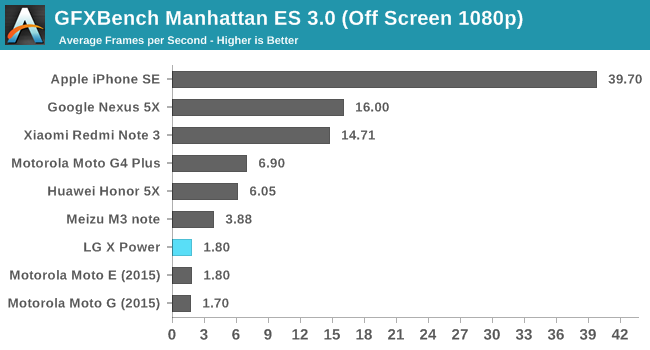
Adreno 304, 305, and 306 are essentially identical, so it's not a surprise to see that the LG X Power sits right beside devices that use Snapdragon 400 and 410 in GFXBench's Manhattan ES 3.0 graphics test. Low end smartphones just don't have great GPU performance, although it won't prevent simple 2D games from being played. I don't expect this to change any time soon for phones that cost close to $100, but I also doubt that it impacts the kind of user that purchases a $100 phone in any appreciable manner.
NAND Performance
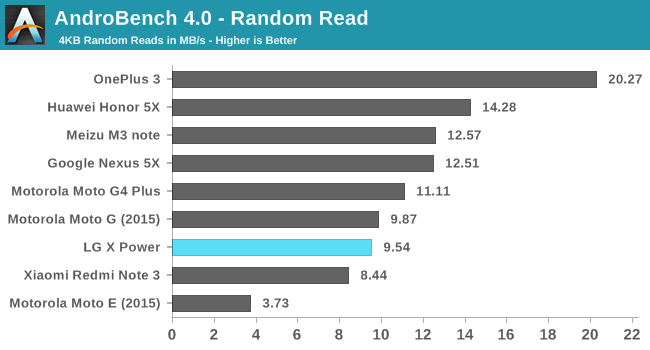


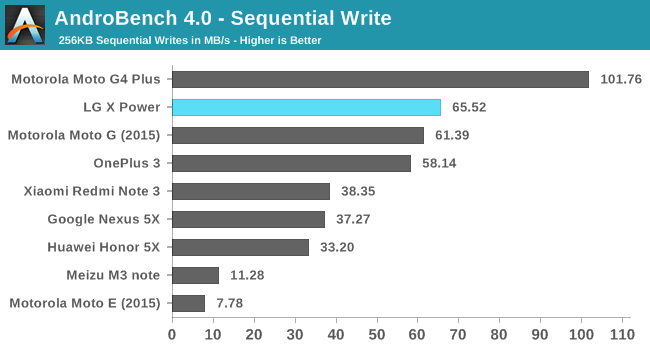
NAND performance on the LG X Power is actually decent as far as low-end smartphones go. Random read and write performance is definitely low, but sequential read and write performance is actually pretty good among the low-end and mid-range phones in the comparison. I don't expect that mid-range smartphones will move away from eMMC storage any time soon, so this is around the best storage performance that you'll see in a $100-150 smartphone.


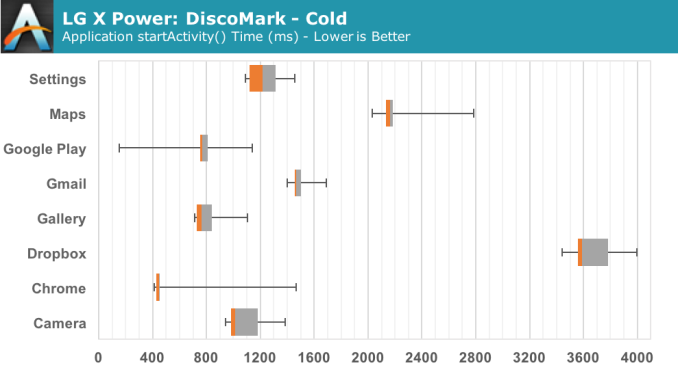
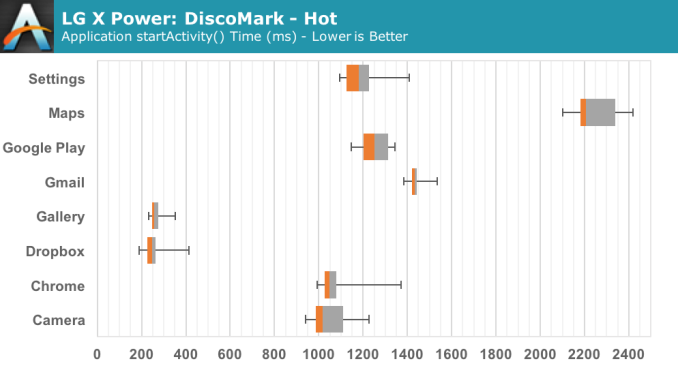








48 Comments
View All Comments
KAKAnuran - Wednesday, August 31, 2016 - link
You don't understand? Money talks here. If anandtech does not receive the check from HTC, they would hold the review until the next generation is coming while no one is paying any attention to the current gen. EVEN THE REVIEWER THINKS THAT HTC 10 IS AN AMAZING PHONEjtang97 - Thursday, September 1, 2016 - link
Yeah, and people are wondering why the HTC 10 doesn't seem to be selling well.Could it be because a very respected website appears to be stalling in publishing their review of the phone?
In my many years of visiting this site and reading their phone reviews (some of which I agree with and some I don't), I've not seen a phone review delayed for so long. Over 3 months and counting now.
I think we are entitled to an explanation a bit more than just "life". Whatever it is, it hasn't stopped him releasing other articles and reviews.
It's almost like you are deliberately delaying the review now.
Meteor2 - Thursday, September 1, 2016 - link
^This.sprockkets - Wednesday, August 31, 2016 - link
I saw this phone at cricket. It surprisingly is lightweight. But the screen on it compared to the Escape 3 is horrible. I wouldn't buy it. I basically can confirm the poor light and colors tested here, and you will notice it next to other phones.shadarlo - Wednesday, August 31, 2016 - link
I wish my S7 or any high end phone would go 1-2mm thicker and make that entire space extra battery capacity. I really really really don't need a phone any thinner than my S7.... what I do need is a full day of USAGE on my phone.I have to carry a giant ass battery brick with me just to keep my S7 topped up on trips when I am driving around and going in and out of good coverage zones. I've had my battery drop from 90%-30% just driving around a national park for a few hours. This is the type of thing phone companies need to work on.... stopping massive drains and giving bigger batteries, not making a tiny phone even tinier.
Notmyusualid - Wednesday, August 31, 2016 - link
As I alluded to earlier, check A9 Pro. I go more than a day with ease.fanofanand - Wednesday, August 31, 2016 - link
A7????? I am a fan of inexpensive phones but this is preposterous.zeeBomb - Wednesday, August 31, 2016 - link
When a phone like this uses a snap 212...huuuge turnoff. I wonder if it's rootable.And Brandon, any foresight of a Moto G play review? Kinda curious how it'll be.
zeeBomb - Wednesday, August 31, 2016 - link
Can anyone who has this (or Brandon) use the AIDA64 app and see what camera sensor it uses?slashbinslashbash - Wednesday, August 31, 2016 - link
Good idea but poor execution. If this phone had all of its limitations but 2X or 3X the battery life of everything else on the market, it might find its niche. But having all of its limitations and only 1.5X the battery life, why would anybody bother?